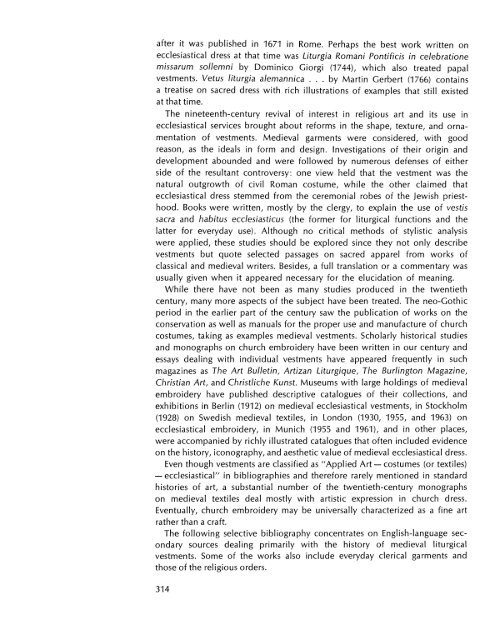The Metropolitan Museum of Art Bulletin, v. 29, no. 7 (March, 1971)
The Metropolitan Museum of Art Bulletin, v. 29, no. 7 (March, 1971)
The Metropolitan Museum of Art Bulletin, v. 29, no. 7 (March, 1971)
Create successful ePaper yourself
Turn your PDF publications into a flip-book with our unique Google optimized e-Paper software.
after it was published in 1671 in Rome. Perhaps the best work written on<br />
ecclesiastical dress at that time was Liturgia Romani Pontificis in celebratione<br />
missarum sollemni by Dominico Giorgi (1744), which also treated papal<br />
vestments. Vetus liturgia alemannica . . . by Martin Gerbert (1766) contains<br />
a treatise on sacred dress with rich illustrations <strong>of</strong> examples that still existed<br />
at that time.<br />
<strong>The</strong> nineteenth-century revival <strong>of</strong> interest in religious art and its use in<br />
ecclesiastical services brought about reforms in the shape, texture, and ornamentation<br />
<strong>of</strong> vestments. Medieval garments were considered, with good<br />
reason, as the ideals in form and design. Investigations <strong>of</strong> their origin and<br />
development abounded and were followed by numerous defenses <strong>of</strong> either<br />
side <strong>of</strong> the resultant controversy: one view held that the vestment was the<br />
natural outgrowth <strong>of</strong> civil Roman costume, while the other claimed that<br />
ecclesiastical dress stemmed from the ceremonial robes <strong>of</strong> the Jewish priesthood.<br />
Books were written, mostly by the clergy, to explain the use <strong>of</strong> vestis<br />
sacra and habitus ecclesiasticus (the former for liturgical functions and the<br />
latter for everyday use). Although <strong>no</strong> critical methods <strong>of</strong> stylistic analysis<br />
were applied, these studies should be explored since they <strong>no</strong>t only describe<br />
vestments but quote selected passages on sacred apparel from works <strong>of</strong><br />
classical and medieval writers. Besides, a full translation or a commentary was<br />
usually given when it appeared necessary for the elucidation <strong>of</strong> meaning.<br />
While there have <strong>no</strong>t been as many studies produced in the twentieth<br />
century, many more aspects <strong>of</strong> the subject have been treated. <strong>The</strong> neo-Gothic<br />
period in the earlier part <strong>of</strong> the century saw the publication <strong>of</strong> works on the<br />
conservation as well as manuals for the proper use and manufacture <strong>of</strong> church<br />
costumes, taking as examples medieval vestments. Scholarly historical studies<br />
and mo<strong>no</strong>graphs on church embroidery have been written in our century and<br />
essays dealing with individual vestments have appeared frequently in such<br />
magazines as <strong>The</strong> <strong>Art</strong> <strong>Bulletin</strong>, <strong>Art</strong>izan Liturgique, <strong>The</strong> Burlington Magazine,<br />
Christian <strong>Art</strong>, and Christliche Kunst. <strong>Museum</strong>s with large holdings <strong>of</strong> medieval<br />
embroidery have published descriptive catalogues <strong>of</strong> their collections, and<br />
exhibitions in Berlin (1912) on medieval ecclesiastical vestments, in Stockholm<br />
(1928) on Swedish medieval textiles, in London (1930, 1955, and 1963) on<br />
ecclesiastical embroidery, in Munich (1955 and 1961), and in other places,<br />
were accompanied by richly illustrated catalogues that <strong>of</strong>ten included evidence<br />
on the history, ico<strong>no</strong>graphy, and aesthetic value <strong>of</strong> medieval ecclesiastical dress.<br />
Even though vestments are classified as "Applied <strong>Art</strong>- costumes (or textiles)<br />
- ecclesiastical" in bibliographies and therefore rarely mentioned in standard<br />
histories <strong>of</strong> art, a substantial number <strong>of</strong> the twentieth-century mo<strong>no</strong>graphs<br />
on medieval textiles deal mostly with artistic expression in church dress.<br />
Eventually, church embroidery may be universally characterized as a fine art<br />
rather than a craft.<br />
<strong>The</strong> following selective bibliography concentrates on English-language secondary<br />
sources dealing primarily with the history <strong>of</strong> medieval liturgical<br />
vestments. Some <strong>of</strong> the works also include everyday clerical garments and<br />
those <strong>of</strong> the religious orders.<br />
314

















